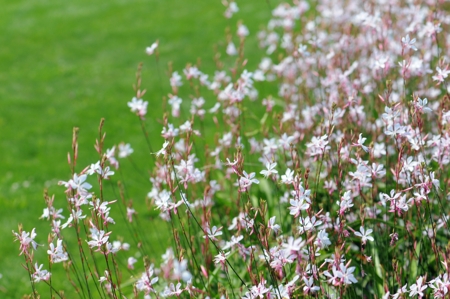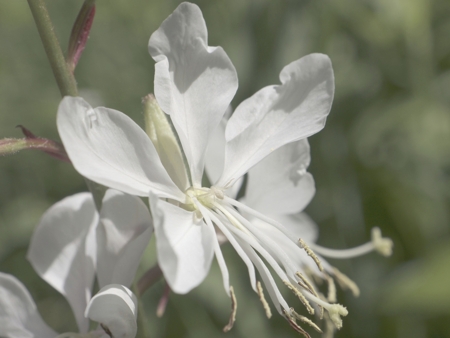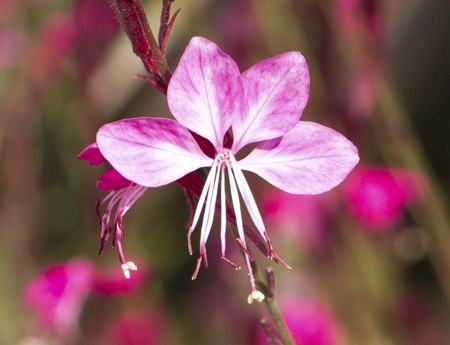





 The name of the species Gaura lindheimeri is derived from the name of the German botanist, Ferdinand Jacob Lindheimer.Otherwise known as bee blossoms and wand flowers, gaura plants belong to the genus Gaura (Oenothera) in the family Onagraceae. Natives to certain parts of North America, these plants grow in clusters and bloom for a long time. While most of the species in this genus are considered as invasive weeds, some are grown for ornamental purposes too. The most popular among them is Gaura lindheimeri, which is now available in numerous varieties.
The name of the species Gaura lindheimeri is derived from the name of the German botanist, Ferdinand Jacob Lindheimer.Otherwise known as bee blossoms and wand flowers, gaura plants belong to the genus Gaura (Oenothera) in the family Onagraceae. Natives to certain parts of North America, these plants grow in clusters and bloom for a long time. While most of the species in this genus are considered as invasive weeds, some are grown for ornamental purposes too. The most popular among them is Gaura lindheimeri, which is now available in numerous varieties. Gaura plants are grown as a perennial in USDA zones 5 to 9. Though these plants are found to overwinter in their native areas, this may not happen in other regions. So, gauras are grown as annuals in such places. Though they are hardy enough to tolerate different growing conditions, it is always advisable to satisfy their basic requirements, if you want them to grow properly and bloom well. Given below are some tips for growing gaura plants.Soil and Light RequirementsGaura plants grow best in well-drained, fertile soil and full sun. They can grow in loam and silt; and may tolerate clay if it is well-drained. The ideal pH level ranges between 6.1 to 8.5. Though these plants love full sun, they may also grow well in partial sun, especially in locations with very hot afternoon sun. These plants require 6 to 8 hours of sunlight daily.Planting GaurasTilling and amending the soil with some compost is good for increasing drainage and for making the soil fertile. While planting gauras, ensure that you leave a space of at least 12 inches between the plants. You can grow them singly or as groups of three to five plants. They are widely grown in beds and borders, and also in containers. Use a well-drained potting medium if you plan to grow them in containers.
Gaura plants are grown as a perennial in USDA zones 5 to 9. Though these plants are found to overwinter in their native areas, this may not happen in other regions. So, gauras are grown as annuals in such places. Though they are hardy enough to tolerate different growing conditions, it is always advisable to satisfy their basic requirements, if you want them to grow properly and bloom well. Given below are some tips for growing gaura plants.Soil and Light RequirementsGaura plants grow best in well-drained, fertile soil and full sun. They can grow in loam and silt; and may tolerate clay if it is well-drained. The ideal pH level ranges between 6.1 to 8.5. Though these plants love full sun, they may also grow well in partial sun, especially in locations with very hot afternoon sun. These plants require 6 to 8 hours of sunlight daily.Planting GaurasTilling and amending the soil with some compost is good for increasing drainage and for making the soil fertile. While planting gauras, ensure that you leave a space of at least 12 inches between the plants. You can grow them singly or as groups of three to five plants. They are widely grown in beds and borders, and also in containers. Use a well-drained potting medium if you plan to grow them in containers. White gaura flower
White gaura flower Pink gaura flowerWatering and FeedingGaura plants are drought tolerant, and can survive without water for a long time. However, proper watering ensures better blooming. Young plants need regular watering till they establish themselves. The frequency of watering can be reduced as the plants grow. Instead of watering the plants superficially on a daily basis, it will be better to water them deeply once a week. Otherwise, water them when the soil gets dry. Feeding is not a necessity, as gauras are well adapted to grow in poor soil. However, you can feed them once in spring, using an all-purpose fertilizer. Too much water or fertilizer may result in leggy flower stalks with less blooms.Pruning and MulchingThough pruning is not needed, you can remove the flower stalks as and when the flowers wither. This is also beneficial for preventing seed formation, as gaura plants are self-seeding. Avoid cutting all the flower stalks at one go, as the plant will take two to three weeks to bloom again. You can also cut back the plants during late spring or early summer. Apply a light layer of mulch after planting, so as to keep weeds at bay. These plants need a thick layer of mulch during winter, in order to protect their roots from the freezing temperatures. You can also cut back the plants before winter.PropagationThe easiest method to propagate gauras is to grow them from seeds. Sow the seeds in the garden during early spring or fall. Dividing the plants during spring is another option, but they have long taproots that may make it difficult for you to dig the plants out. You have to water them deeply before you dig out the plants. Each taproot has to be separated along with its stems. Once done, you can plant them in the garden bed that is already prepared. You can also propagate these plants using their hardwood cuttings during summer, or softwood cuttings in spring.Gaura plants are easy to grow and need minimal care and maintenance. They are also resistant to many diseases and pests. However, these plants may develop root rot if grown in poorly drained soil. Leaf spots, rust, and mildew may also appear in them. Good air flow may prove beneficial to prevent such conditions. Aphids, spider mites, and white flies may attack these plants at times. Contact a local nursery authorities for inputs regarding pest and disease control in gaura plants.
Pink gaura flowerWatering and FeedingGaura plants are drought tolerant, and can survive without water for a long time. However, proper watering ensures better blooming. Young plants need regular watering till they establish themselves. The frequency of watering can be reduced as the plants grow. Instead of watering the plants superficially on a daily basis, it will be better to water them deeply once a week. Otherwise, water them when the soil gets dry. Feeding is not a necessity, as gauras are well adapted to grow in poor soil. However, you can feed them once in spring, using an all-purpose fertilizer. Too much water or fertilizer may result in leggy flower stalks with less blooms.Pruning and MulchingThough pruning is not needed, you can remove the flower stalks as and when the flowers wither. This is also beneficial for preventing seed formation, as gaura plants are self-seeding. Avoid cutting all the flower stalks at one go, as the plant will take two to three weeks to bloom again. You can also cut back the plants during late spring or early summer. Apply a light layer of mulch after planting, so as to keep weeds at bay. These plants need a thick layer of mulch during winter, in order to protect their roots from the freezing temperatures. You can also cut back the plants before winter.PropagationThe easiest method to propagate gauras is to grow them from seeds. Sow the seeds in the garden during early spring or fall. Dividing the plants during spring is another option, but they have long taproots that may make it difficult for you to dig the plants out. You have to water them deeply before you dig out the plants. Each taproot has to be separated along with its stems. Once done, you can plant them in the garden bed that is already prepared. You can also propagate these plants using their hardwood cuttings during summer, or softwood cuttings in spring.Gaura plants are easy to grow and need minimal care and maintenance. They are also resistant to many diseases and pests. However, these plants may develop root rot if grown in poorly drained soil. Leaf spots, rust, and mildew may also appear in them. Good air flow may prove beneficial to prevent such conditions. Aphids, spider mites, and white flies may attack these plants at times. Contact a local nursery authorities for inputs regarding pest and disease control in gaura plants.
Copyright © www.100flowers.win Botanic Garden All Rights Reserved